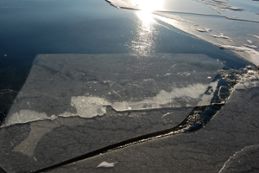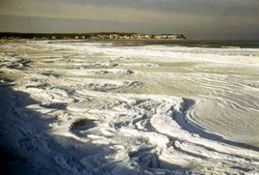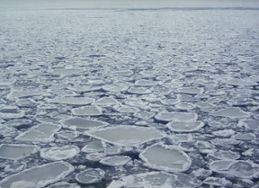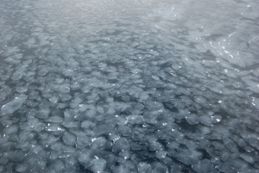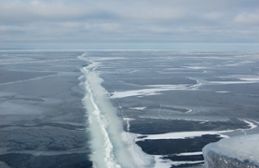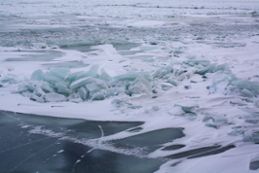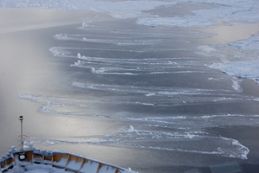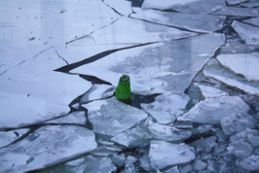In winter, ice forms on lakes, water courses and the sea. The salt in the sea means that ice can only form when the sea surface temperature is below zero degrees Celsius. The character of the ice varies with the saltiness of the water. For lakes and along the coast of Northern Sweden the ice is hard and clear. In the saltier water of Skagerrak the ice is less hard, and is instead grainy and porous, although still solid.
When the weather is calm and cold, new ice forms a thin film on the surface. This mostly happens in the still waters of the archipelago and in small bays. If the wind freshens, the ice film cracks and the warmer water underneath will come to the surface. If however the weather continues to be favourable for ice formation, the ice film will grow over one or more days, producing smooth, continuous new ice.
New ice (nilas)
When ice first starts forming, new ice, or nilas, is created. This is transparent, elastic and just a few centimetres thick. In the archipelagos it is often shiny and black. At sea, where the wind and waves mix the water, ice forms in a different way.
Solid ice
The next stage of development is the non-transparent, greyish solid ice. It does not need to be attached to land (fast ice) but is often continuous and unmoving. Solid ice consists partly of core ice, created when sea water freezes underneath the ice layer, and partly of snow ice that is formed when wet snow freezes on the top of the ice layer. It is often then covered by a blanket of snow.
Shuga, slush
In the open sea the water is often not still enough to form a layer of ice. The wave movement keeps circulating the water in the top layer so that the whole layer cools in the same way. In cold weather, ice crystals form on the surface, but do not freeze together because of the mixing in the water, and instead are mixed down to a depth of several metres.
As more and more ice crystals form, clusters are created and become a floating mush that dampens the wave movement and therefore accelerates ice formation. This ice slurry is called shuga, or slush.
Pancake ice
Waves and wind compress the ice particles into larger plates. These float on the ocean surface, and collide with one another, forming platters with upturned white edges. Each plate is between 30 cm and 3 m in diameter and up to 10 cm thick.
A similar type of ice can also be formed from nilas that were originally continuous ice sheets: If the water becomes agitated the nilas can break up and become irregular polygons that become rounder with time. A closer look is needed to differentiate between these and "real" pancake ice.
Platelet ice
On the Swedish west coast and in the more southern parts of the Baltic, platelet ice can form at depths of several metres.
For this to happen, there must be two layers of water: a top cool layer of brackish water and a colder saltier layer underneath. The saltier layer must have been cooled to below zero Celsius – though not sufficiently to freeze - usually as the surface layer. When this cold salty water meets the brackish (and lighter) water, it dives underneath it (or alternatively, it can be said that the brackish water forms a layer on top of the cold salty water).
Along the interface where the cool brackish and cold salty water meet, the brackish water freezes (as its freezing point is higher than that of the salty water). Large round, flat plates of ice float to the surface with a splash. In this way, large areas of sea can become covered with platelet ice in just a few hours.
Jammed brash barrier
Hard winds and waves can compress pancake ice, broken nilas or slush against land or solid ice forming a thick ridge of brash ice. This may only be slightly raised above the surrounding ice but can extend to several metres depth.
A jammed brash barrier can be several nautical miles long, causing significant problems for vessels trying to break through it. If the wind eases or changes direction, the brash barrier may loosen and disappear. However it can also freeze solid creating an unusually thick ice sheet, much thicker than the surrounding ice.
Ice ridges
Ice thicker than 15-20 cm forms ice ridges. Ice floes can be pressed against land, against fast ice or against slow-moving ice floes. Ridges are formed where ‘floebits’ are thrown haphazardly on top of each other like floating timbers.
The part above the water (called the sail) is only one or a few metres high while the underwater part (the keel) can extend up to several tens of metres deep. The floes are usually not frozen together.
If an ice ridge is covered in snow it can look quite harmless. However, they cause problems for sea traffic. Ridges can often become grounded in shallower water and if this continues the floes can form huge piles of ice.
Rafted ice
Sea ice is strongly affected by wind and currents. Depending on its thickness it can be easily broken up as the wind picks up. If the ice is relatively thin and even, the floes or ice fields often glide on top of each other. The edges often create a zigzag pattern with “fingers” that glide either over or under each other. In this way ice thickness can rapidly increase.
Drift ice
Drift ice is any sort of sea ice affected by wind and currents, as opposed to fast ice which is attached to islands or the coast. It can take the form of different sizes of floe but can also be frozen together in large ice fields of varying thickness and roughness. It can form from fast ice that has broken loose from unprotected stretches of coast, or form in the open sea during calm weather.
Drift ice is a continuous hazard to sea traffic. It is never still, even if changes are sometimes unnoticeable. Out at sea, ice leads do not stay open in the same way as in the archipelago and can quickly close up, creating ridges that are difficult to break through.
Floebergs, floebits
As the ice breaks up, single large pieces of drift ice from old ridges are left, called floebergs. These can often be surrounded by open water.
Floebergs are difficult to see. The top can be dark and porous and only just above the surface, while the main part of the Floebergs is under water and can be both large and hard. Floebergs are a potential threat to sea traffic during darkness or poor visibility.
Floebergs are similar to growlers (small icebergs) but growlers and icebergs are by definition formed on land, for example by calving from glaciers.
Rotten ice
As ice starts to melt it becomes honeycombed and porous, and is said to be rotten. It can be 20-30 cm thick but is not supportive. The ice is about to break up (but doesn’t smell as might be suggested by the name). If a ship breaks through the ice the crystals fall apart and the ice quickly dissolves.
